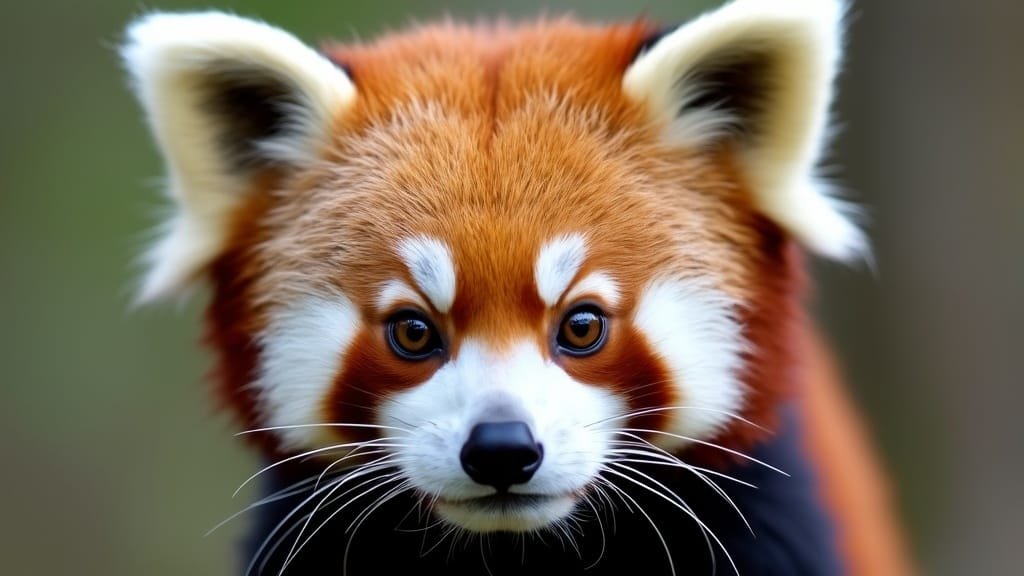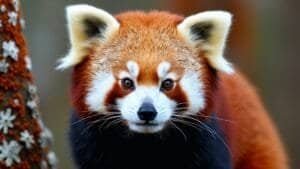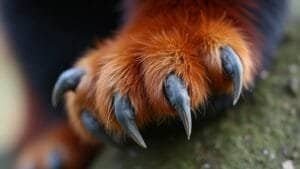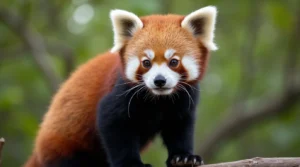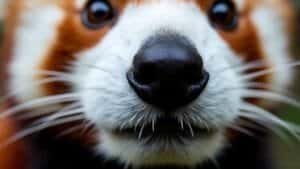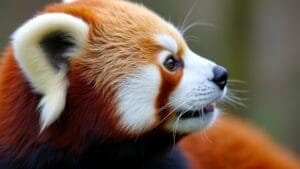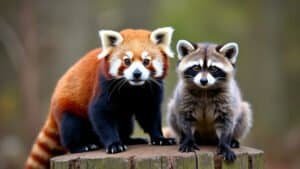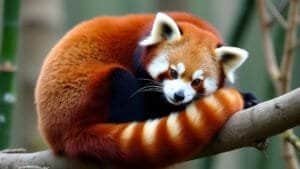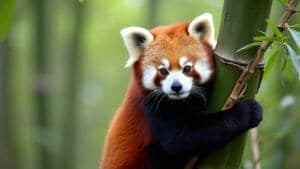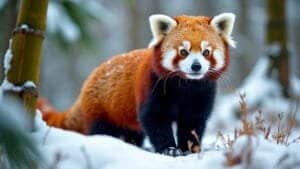Red pandas are often described as having cat-like faces due to their rounded facial structure, short muzzles, expressive eyes, and long whiskers. These physical traits give them an appearance similar to domestic cats, despite being more closely related to raccoons and weasels. Their facial markings further enhance this resemblance, with white patches around their eyes and cheeks creating a visually striking contrast, much like the expressive faces of some feline species
Beyond their physical characteristics, red pandas also share certain behavioral similarities with cats, such as grooming habits and facial expressions that convey curiosity and alertness. However, their resemblance to felines is primarily the result of evolutionary adaptations suited to their arboreal lifestyle, sensory needs, and diet. In this article, we’ll explore the anatomical features, behaviors, and evolutionary traits that contribute to the red panda’s cat-like appearance while distinguishing them from their true relatives in the animal kingdom
Physical Features That Make Red Pandas Look Like Cats
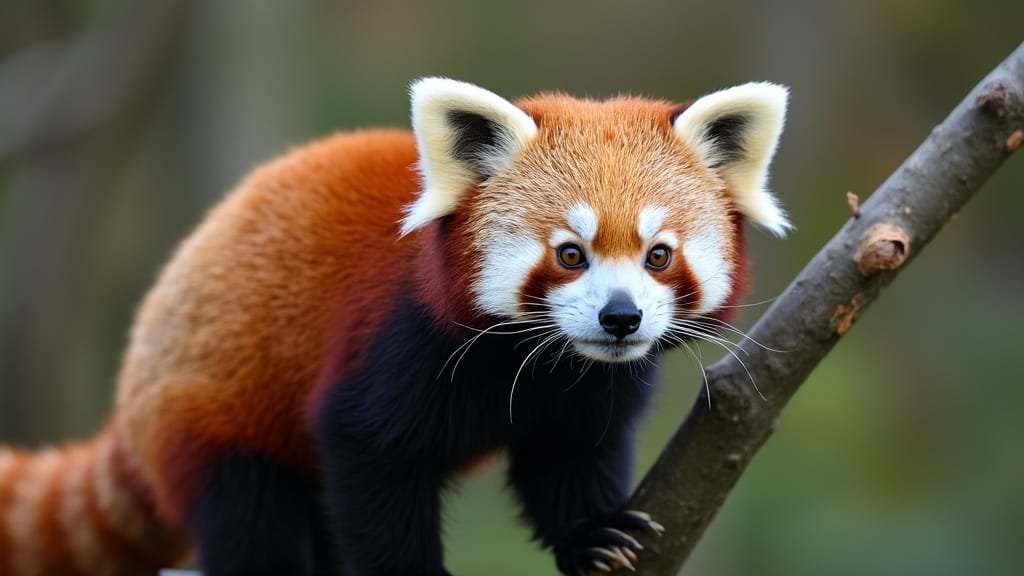
The red panda’s resemblance to domestic cats is largely due to its unique facial structure and features. From its rounded skull and short muzzle to its large eyes and long whiskers, these traits create a feline-like appearance. Although red pandas are not closely related to cats, their evolution has shaped their faces in ways that make them look strikingly similar
The Role of Skull Shape and Facial Proportions
One of the most defining features that contribute to the red panda’s cat-like face is the shape of its skull. Red pandas have a short, broad skull with a reduced rostrum (snout), giving their faces a compact and rounded appearance. This is a key characteristic shared with felines, which also have relatively short muzzles compared to other carnivorous mammals
The compact skull structure influences not only the red panda’s appearance but also its feeding behavior and sensory perception. A study by Wei et al. (Journal of Mammalogy, 2014) found that red pandas evolved a shorter snout as an adaptation to their bamboo-based diet, similar to how cats have short muzzles optimized for biting and tearing meat. This shared skull feature is one of the primary reasons why red pandas and cats have such similar facial proportions
Why Red Pandas Have Large Eyes and Short Muzzles
Another reason why red pandas resemble cats is their large, forward-facing eyes, which enhance their expressive facial appearance. These large eyes are essential for their crepuscular activity patterns, meaning they are most active during dawn and dusk. Like domestic cats, red pandas rely on their keen eyesight to navigate their dense forest habitat in low-light conditions
Additionally, their short muzzles contribute to their feline-like look. Unlike raccoons or foxes, which have elongated snouts, red pandas have compact, rounded faces that make their eyes appear larger and more expressive. This proportion is a common trait in felines, which also have relatively small snouts compared to their overall head size
A comparative study by Choudhury (Journal of Zoology, 2001) noted that the short muzzles and large eyes of red pandas are adaptations for arboreal life, helping them focus on their immediate surroundings as they climb and forage in the forest canopy. These same adaptations create the striking resemblance between red pandas and domestic cats
The Importance of Whiskers and Facial Markings
Red pandas also have long, well-developed whiskers (vibrissae), which enhance their feline-like appearance. These whiskers, extending from their muzzle and cheeks, serve as sensory tools that help them detect objects and navigate their environment. This function is identical to that of domestic cats, which use their whiskers to measure spaces and detect movement
In addition to their whiskers, red pandas have distinctive facial markings, including white patches around their eyes and cheeks. These markings create a sharp contrast with their reddish-brown fur, giving them an expressive look similar to certain cat breeds with distinct facial patterns, such as the Maine Coon or the Bengal cat
According to Roberts and Gittleman (Mammalian Biology, 2020), these facial markings may also serve a communication function, helping red pandas recognize one another in their dense forest environment. This is another trait they share with cats, which often use facial expressions and markings to communicate subtle social cues
For more insights into the red panda’s facial structure and its resemblance to felines, visit the Red Panda Network’s fact sheet
Behavioral Traits That Enhance the Feline Resemblance
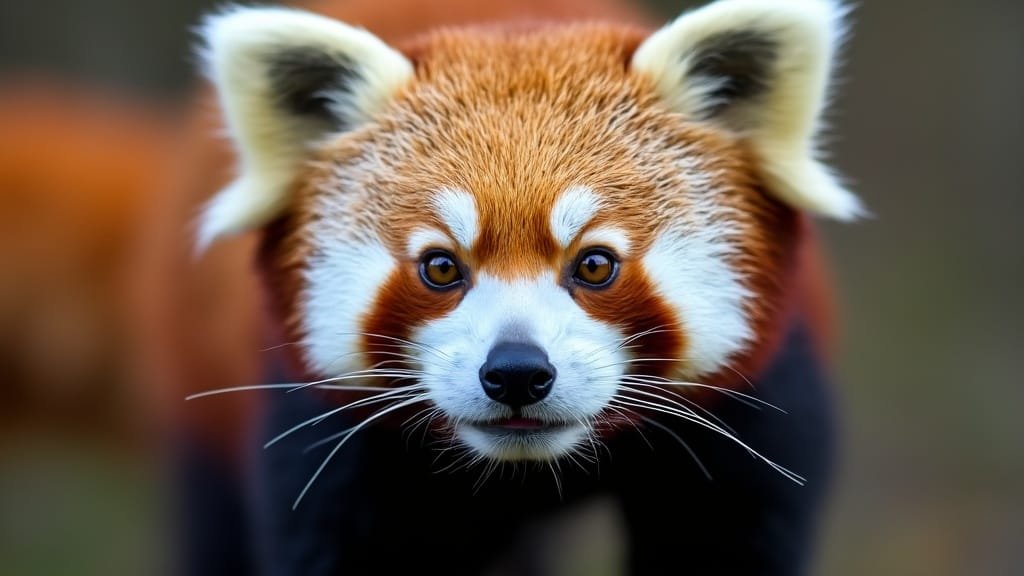
While the red panda’s physical features contribute to its cat-like appearance, its behavioral traits further reinforce the resemblance. From grooming habits and ear movements to expressive facial behaviors, many of the red panda’s daily activities mirror those of domestic cats. These similarities, although largely coincidental, make red pandas seem even more feline-like in their movements and expressions
Grooming Habits Similar to Domestic Cats
One of the most striking behavioral similarities between red pandas and cats is their self-grooming routine. Like domestic cats, red pandas lick their fur and paws to clean themselves, maintaining their thick coats in good condition. This behavior is essential for regulating body temperature, removing dirt, and keeping their fur free of debris
In addition to licking their fur, red pandas use their front paws to wipe their faces in a motion that is almost identical to a cat’s grooming technique. This action is often observed after eating or waking up from a nap. A study by Choudhury (Journal of Zoology, 2001) found that self-grooming in red pandas serves both hygienic and thermoregulatory purposes, much like in felines, which clean their fur not only for hygiene but also to cool down through the evaporation of saliva
Ear Shape and Movement Compared to Felines
Red pandas also share similarities with cats when it comes to ear shape and movement. Their small, triangular ears are positioned symmetrically on their heads, much like those of domestic cats. These ears are highly mobile and can rotate slightly to detect sounds, allowing red pandas to stay alert to their surroundings even while resting
Cats use their ears to pick up faint noises and detect movement, an ability that is essential for hunting. While red pandas are not predators, their sensitive hearing helps them detect potential threats and other animals in their environment, including mates or rivals. A comparative analysis by Wei et al. (Journal of Mammalogy, 2014) found that the range of ear movement in red pandas is similar to that of small wild felines, suggesting that both species rely on acute hearing for survival in complex environments
How Red Pandas Express Emotions Through Facial Features
Like cats, red pandas have highly expressive faces that convey emotions through subtle movements of their eyes, ears, and mouths. Their large, forward-facing eyes can widen in response to curiosity or excitement, while their ears may tilt slightly when they are alert. These small but noticeable facial expressions make red pandas appear even more cat-like
Red pandas also share some defensive expressions with cats. When threatened, they may arch their backs and raise their tails, a posture that resembles a frightened cat trying to appear larger. This display, combined with a direct stare and slightly open mouth, serves as a warning signal to potential threats. A behavioral study by Roberts and Gittleman (Mammalian Biology, 2020) noted that these expressive postures help red pandas communicate with minimal vocalizations, similar to how cats use body language more than sound to interact with other animals
For further reading on red panda behaviors and their similarities to feline traits, visit the Smithsonian National Zoo’s red panda profile
Evolutionary and Taxonomic Perspective
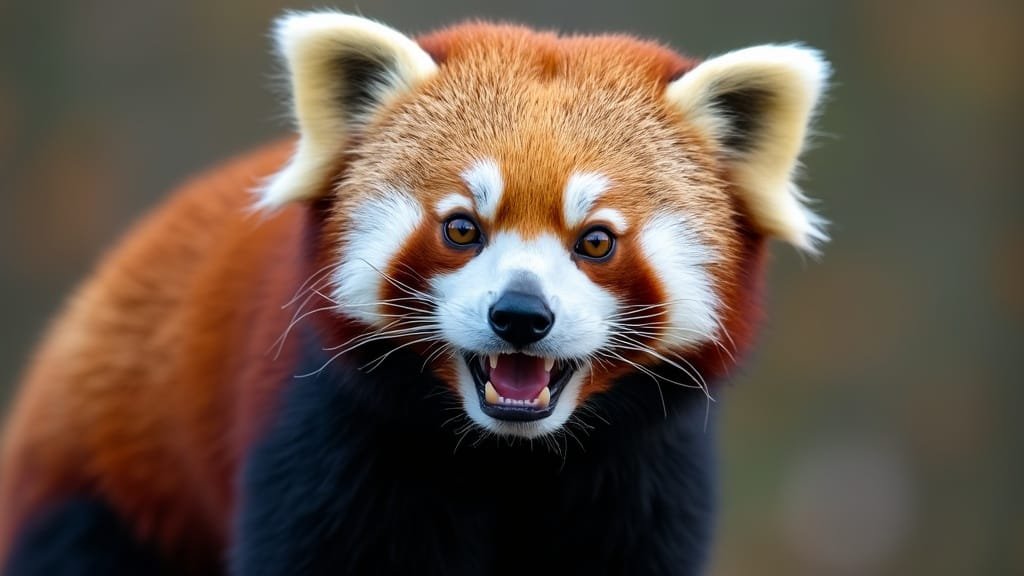
Although red pandas share many physical and behavioral similarities with cats, their resemblance is largely coincidental. Evolution has shaped their features based on their unique ecological niche, not because of any close genetic relationship to felines. Understanding their evolutionary history and taxonomic classification helps clarify why red pandas look like cats while belonging to an entirely different branch of the animal kingdom
Are Red Pandas Related to Cats?
Despite their cat-like faces, red pandas are not closely related to domestic cats. They belong to the family Ailuridae, a unique taxonomic group that diverged from other carnivorous mammals millions of years ago. In contrast, domestic cats belong to the family Felidae, which includes big cats such as lions, tigers, and leopards
Red pandas share a more recent common ancestor with raccoons, weasels, and skunks, placing them in the larger order Carnivora. However, their classification within Carnivora is distinct due to their evolutionary adaptations, particularly their diet. While most members of Carnivora are meat-eaters, red pandas are primarily herbivorous, feeding almost exclusively on bamboo. A study by Flynn et al. (Molecular Phylogenetics and Evolution, 2005) found that red pandas diverged from their closest relatives around 18 million years ago, long before the evolution of modern felines
Differences Between Red Pandas, Raccoons, and Weasels
Although red pandas resemble cats, they are more closely related to raccoons and weasels. However, even within this broader taxonomic group, they have evolved distinct facial features that set them apart
Raccoons, for example, have longer snouts and distinctive black “mask” markings around their eyes, which give them a very different facial structure from red pandas. Weasels, on the other hand, have elongated, narrow faces suited for burrowing and hunting small prey. In contrast, red pandas have short, rounded faces with expressive eyes and distinctive white facial markings, making them look more like felines than their closest relatives
A comparative analysis by Wei et al. (Journal of Mammalogy, 2014) suggests that the red panda’s facial shape evolved as an adaptation to its diet and arboreal lifestyle. Unlike raccoons and weasels, which rely on hunting or scavenging, red pandas primarily consume bamboo. Their short snouts and strong jaw muscles are better suited for chewing tough plant material, leading to the development of a more compact skull shape. This evolutionary shift, while functionally beneficial, also gives red pandas their distinctive cat-like appearance
How Evolution Shaped the Red Panda’s Facial Structure
The red panda’s facial features are a result of millions of years of evolutionary pressure to adapt to its environment. Its rounded skull, large eyes, and short muzzle are all adaptations that support its survival in dense forests and high-altitude habitats. The evolution of these traits was not driven by a need to resemble cats but rather by practical adaptations that enhanced their ability to forage, navigate trees, and detect predators
One key evolutionary factor shaping their facial structure is their bamboo-based diet. Because bamboo is fibrous and requires significant processing, red pandas developed strong jaw muscles and broad skulls to support powerful chewing. This adaptation inadvertently contributed to their round, cat-like facial proportions. Another important factor is their arboreal lifestyle, which favors animals with forward-facing eyes for depth perception. This feature is common in both red pandas and cats, as both species rely on their vision to navigate complex environments, whether climbing trees or stalking prey
A study by Choudhury (Journal of Zoology, 2001) noted that the evolution of short snouts in red pandas is also linked to sensory efficiency. A compact muzzle allows them to bring food closer to their eyes while eating, improving their ability to assess and manipulate bamboo. This adaptation is functionally similar to how felines evolved short muzzles for precision biting and hunting, further reinforcing the superficial resemblance between the two species
For more insights into the evolutionary history of red pandas and their classification, visit the Red Panda Network’s scientific resources
